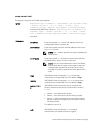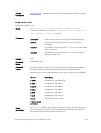
[access access-list-name | ipv6 access-list-name | access-list-
name ipv6 access-list-name]
To remove a user from the SNMP group, use the no snmp-server user name
{group_name remote ip-address vrf vrf-name udp-port port-
number} [1 | 2c | 3] [encrypted] [auth {md5 | sha} auth-
password] [priv {des56 | aes128} priv password] [access access-
list-name | ipv6 access-list-name | access-list-name ipv6
access-list-name] command.
Parameters
name Enter the name of the user (not to exceed 20 characters), on
the host that connects to the agent.
group_name Enter a text string (up to 20 characters long) as the name of
the group. The following groups are created for mapping to
read/write community/security-names (defaults):
• v1v2creadu — maps to a community with ro
permissions.
• 1v2cwriteu — maps to a community rw permissions.
remote ip-
address
Enter the keywords udp-port then the user datagram
protocol (UDP) port number on the remote device. The
range is from 0 to 65535. The default is 162.
vrf vrf-name Enter the keywords vrf and then the name of the VRF this is
used to connect to the SNMP server.
NOTE: Use this attribute to specify a VRF name that is
used to connect to the remote host. If no VRF is
specified, then the default VRF is used.
udp-port port-
number
Enter the keywords udp-port then the UDP (User Datagram
Protocol) port number on the remote device. The range is
from 0 to 65535. The default is
162.
1 | 2c | 3 (OPTIONAL) Enter the security model version number (1, 2c,
or 3):
• 1 is the least secure version.
• 3 is the most secure of the security modes.
• 2c allows transmission of informs and counter 64, which
allows for integers twice the width of what is normally
allowed.
The default is 1.
encrypted (OPTIONAL) Enter the keyword encrypted to specify the
password appear in encrypted format (a series of digits,
masking the true characters of the string).
auth (OPTIONAL) Enter the keyword auth to specify
authentication of a packet without encryption.
1712
Simple Network Management Protocol (SNMP) and Syslog


















